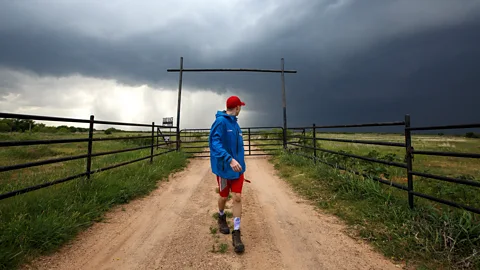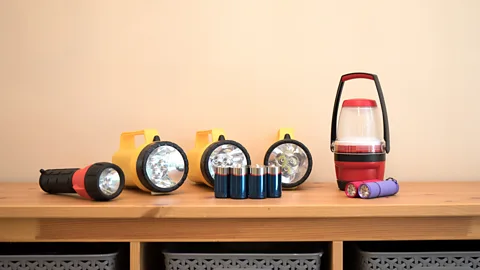In a warmer world, tornado behaviour is changing – this is how we can prepare
 Getty Images
Getty ImagesClimate change is causing America's tornados to touch down in new locations, and occur at different times. Experts explain how best to prepare for these hard-to-predict disasters.
Across the Great Plains of the US Midwest, peak tornado season arrives in June and July. Already, tornadoes have caused devastating harm in the US, including in Oklahoma and Kansas, as well as in the states of Iowa, Michigan, and Texas.
As the National Severe Storms Laboratory at the National Oceanic and Atmospheric Administration (Noaa) notes, tornadoes can happen any time of the year. Due to climate change, tornado season is expected to change both in location and duration – adding another layer of complexity when it comes to preparing for the potentially violent phenomena. (Read more about how tornado alley is changing.)
Around 1,200 tornadoes hit the US every year. They consist of narrow, rotating columns of air that extend from a thunderstorm to the ground, gathering dust and debris beneath the swirling funnel. Tornado strength is measured by the damage they cause.
Unlike the connection between climate change and other weather phenomena such as hurricanes, establishing a clear link between much more fleeting, smaller scale weather events like tornadoes is difficult – but not impossible. And given that tornadoes are already so hard to predict, how can we best prepare for them in a warming world?
"We expect that the number of days in any given year that are favourable for tornadoes… are going to increase in the future and specifically increase earlier in the season," Victor Gensini, associate professor of meteorology at Northern Illinois University, tells the BBC.
Greenfield, Iowa tornado
A tornado struck the small town of Greenfield in Iowa on Tuesday 21 May 2024.
The tornado killed several people, the state police said, devastating a "good portion" of the town.
"It was just a few weeks ago that tornadoes hit several other Iowa communities, and it's hard to believe that it's happened again," Iowa Governor Kim Reynolds said in a statement.
Across the US's southern Plains states like Oklahoma and Kansas, "what might have been May and April as your peak months are now March, April, and May or even February", Gensini says. He notes that there hasn't been an uptick in strong tornadoes – tornadoes at EF4 ratings and higher – over the last 50 years, but where they occur has been changing.
States notorious for tornadoes such as Texas, Oklahoma and Kansas are actually seeing a decrease in tornadoes while states like Tennessee, Georgia and Arkansas as well as upper Midwest states like Minnesota, Illinois and Iowa are seeing an increase.
"We have way more people living in the mid-south and east of the Mississippi River than we do in the Great Plains," Gensini says. The higher population densities of the states seeing an increase in storms means that they have the potential to do more damage.
As tornado seasons and locations change, one thing remains the same – the importance of preparation.
"It really starts with awareness," says David Titley, who was previously a rear admiral, oceanographer, and navigator of the US Navy. He also served as Noaa's chief operating officer before co-founding RV Weather Enterprises, which provides weather information and routing services to road travellers.
 Getty Images
Getty ImagesHow severe is a tornado?
Tornados are measured using the Enhanced Fujita Scale (EF Scale), which rates tornados based on estimated wind speeds based on the damage caused. The estimates for a gust lasting over three seconds correspond to EF ratings from zero to five:
EF0: 65-85mph/105-137kph
EF1: 86-110mph/138-177kph
EF2: 111-135mph/178-217kph
EF3: 136-165mph/219-266kph
EF4: 166-200mph/267-322kph
EF5: Over 200mph/322kph
The scale builds on the Fujita Scale, which runs from F0 (gale) to F5 (incredible), which was replaced by the EF Scale in 2007.
You can read more about the EF Scale on the National Weather Service website.
For those looking to prepare, Titley notes that Noaa's National Weather Service issues severe weather outlooks, watches and warnings, all of which should be paid attention to through reliable devices. Local TV stations will put out screen crawlers or interrupt broadcasts entirely to cut to meteorologists when warnings are issued. Radio works as well, but only if you're familiar with the local geography because the information is typically broken down by county.
Those who have moved away from television and radio in favour of digital services can get information from the National Weather Service's account on X, formerly Twitter.
At the other end of the spectrum, there's the very old-school Noaa Weather Radio, which requires a special radio receiver or scanner capable of picking up 24-hour broadcasts of official warnings, watches, forecasts and other hazard information from Noaa. "Some people make fun of them," Titley says of the weather radios. "It's probably 60-year-old technology, but it's kind of fool proof. It doesn't rely on the internet. It doesn't rely on cable. It doesn't rely on cell service." Titley has two portable versions, one for his RV and another for his truck.
Trudy Thompson Shumaker, a volunteer and national spokesperson for the American Red Cross, says that education is key to preparing for tornadoes. "Know what to do and how to stay safe," she says. This starts with identifying the safest room in your home – an interior, windowless space. Bathrooms sometimes meet these requirements, but a closet can also work as can an emergency stairwell in larger buildings.
She also suggests assembling an emergency kit that contains the supplies necessary for sheltering in place for two weeks. "You'll need water because the water supply may be unsafe. You'll need a battery-powered radio and phone chargers," says Thompson Shumaker. Before a tornado strikes, "go through your phone and write down the important numbers you'll need if your phone goes dead".
She also suggests keeping a list of all necessary medications. In the event of a disaster, the Red Cross can help replace lost medications or medical devices at no cost to you. "It won't be a three-month supply, but it will be enough to get you through the immediate time period," she says.
 Getty Images
Getty ImagesShoes, according to Thompson Shumaker, are another important consideration. She likes to go barefoot as often as possible while others around her Arizona home prefer flip flops, but keeping a sturdy pair of shoes nearby will come in handy during a disaster event that's littered the ground with debris like shattered glass, she says.
Finally, Thompson Shumaker says that the American Red Cross's free Emergency App is another helpful tornado-preparation tool. By setting it to your zip code and those of your loved ones, you can be alerted to a range of hazards, from earthquakes and fires to tornadoes and hurricanes.
Even without the app, you can call 1-800-RED-CROSS and, no matter where you are, "they'll patch you through, connect you to volunteers closest to you, and we'll get you fixed up", says Thompson Shumaker.
--
For essential climate news and hopeful developments to your inbox, sign up to the Future Earth newsletter, while The Essential List delivers a handpicked selection of features and insights.
